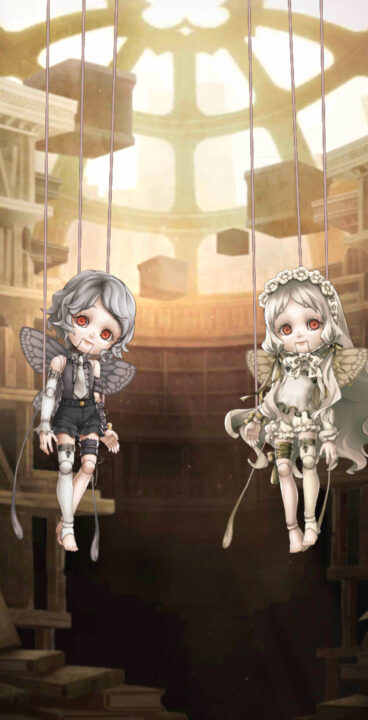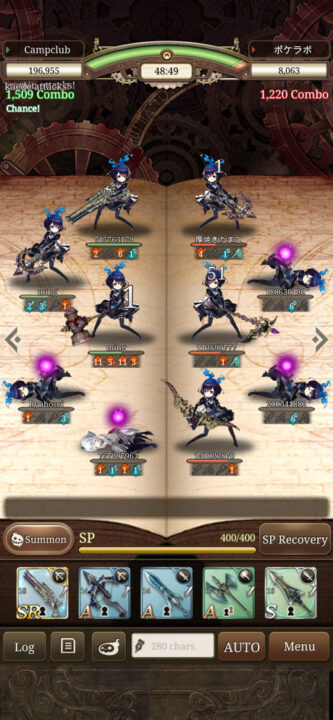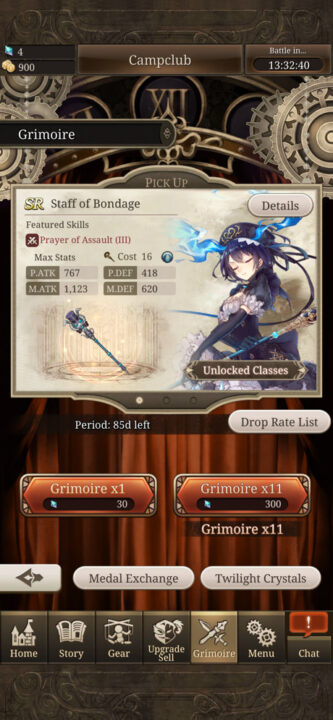If you could meet the author of your life — the divine creator or god overseeing your existence, if such an entity exists — would you ask for a mulligan? A do-over? Maybe some changes around the edges, or a complete overhaul to your story?
In SINoALICE, this question is posed to some well-known characters from children’s fairy tales, many of whom have had their stories told by the likes of Disney. But creator and writer Yoko Taro, known for his own warped tales in the NieR franchise, decided to put a twist on each story. And before we even touch the nature of this game’s mechanics, I think it’s important to discuss concept, plot, and dialogue, as this is the single most story-driven RPG I’ve played for mobile platforms.
SINoALICE takes place in a special realm or dimension: a vast library that seems to stretch on endlessly. Two puppets, essentially the narrators or Greek chorus for the game, help guide the player and the playable characters through this world, egging them on with the possibility of reviving their authors for whatever ends they see fit. Titular character Alice, from Lewis Carroll’s two-part fantasy novels, feels a bond with her author and only wishes to revive him so that she can meet him.
Each fairy tale character is assigned a main descriptive trait in their biography. For example, Alice experiences “bondage.” The characters — many of whom come from the Brothers Grimm canon — are shaped and warped by their key traits. Gretel’s “delusion” leads her to believe things that simply cannot be true; Sleeping Beauty’s “languor” sends her on a quest for eternal sleep, even if it means killing off prince charming; Snow White’s “justice” makes her think that the nightmarish creatures she murders left and right deserve to die for blocking her path to reviving her authors. And as the plot progresses for each character, the rabbit hole grows deeper and darker than before.
The game’s story is presented simply enough: at the beginning of each short battle sequence (called a “verse”), text and character art appear. Typically this text is longer at the beginning and end of each chapter (which is usually comprised of ten verses). But even the short text with each verse gives flavor to the characters.
Based on this text alone, you might get a sense for where each character’s head is at, but that state of mind is not static: the protagonists’ opinions shift over time, though not necessarily to anything less warped or tragic. For example, it’s plain to see that the Three Little Pigs (all depicted as thin) have self-image issues and eating disorders. The more you play, the more apparent this becomes. The puppets tease masochistic Kaguya of being “a perv” because of her desire to be dominated by someone stronger than her. Cinderella breaks the fourth wall by decrying our culture’s obsession with certain standards of beauty; she is ready to burn it all down and find her own path. Pinocchio, the “dependent” one, has a long staff he carries, certainly meant to represent both a phallic object and a stand-in for his nose that grows when he lies. His problems and pending fate are too tragic and upsetting for me to even touch in this review.

Now, here comes the crazy part. As rich and twisted as all of this is, it’s just one facet of the game’s fantastic writing. Just as in the Drakengard and NieR games, each weapon in SINoALICE has its own short story. Side stories appear, often with original tales that have similar themes to other characters in the main story. For example, weeks before writing this review, a story went up about a man who goes to a war-torn country and works hard to save children by starting an orphanage. When he runs low on funding and is desperate to help, he starts digging through the mass graves of children he couldn’t save and resorts to cannibalism to keep the other children alive: all without telling those children what he’s doing. The story is presented as a lengthy diary, with challenging battles between every few pages to keep you going. Most disturbing is that the boss enemies you fight are the voices of the dead children, haunting the diary’s author and the player all at once. As for which character the cannibalism relates to, I don’t want to give that away. Play it for yourself.
Another surprisingly good side story is the Space Invaders crossover. The chapters are essentially a detailed historical account of why the game was so successful — how it was one of the first arcade games where the AI opponent responded to your shots and made gameplay challenging. Esoteric details about the game, as well as its eventual demise in arcades thanks to hundreds of thousands of knockoff bootleg-manufactured arcade cabinets, are all presented before the story eventually wraps up with details of Taito being acquired by Square Enix. In the final analysis, puppets Parrah and Noya suggest that with the frequent turnover and life cycle of mobile RPGs, SINoALICE will become obsolete long before Space Invaders and will have a much smaller impact on the gaming industry. Without a doubt, this breaking of the fourth wall is a Yoko Taro trademark move. And it’s bold as hell.
Visually, SINoALICE is a mobile masterpiece. The character designs for each protagonist are amazing. The background art and animation for the library, the Grimoire summoning room, and the puppets Parrah and Noya are a wonderful mix of charming and haunting. The high-res character and enemy sprites are well animated and blend nicely between the game’s main cast and crossover characters alike. (Three floating Emil heads from NieR Automata fighting alongside Sleeping Beauty? Why not!)
Everything is amazing on the aural spectrum as well. Almost all game text is voiced, exclusively in Japanese. But you really don’t need English voices to understand what’s happening with intonation. In fact, the Japanese voices fit the characters remarkably well, and even though English speakers get what is essentially a subtitled experience, there’s no question that it’s a marvelous one. The character traits — brutality, depravity, masochism, curiosity — are all expressed perfectly by the voice actors.

As for the soundtrack? Outside the context of the game, it’s a decent effort from the MONACA team (Keiichi Okabe and friends). More details about the soundtrack can be found in my review of the album. Within the context of the game, the music reaches new heights. From the moment you hit the title screen, the piano and strings whisk you away to this fantastic library. Emotionally stirring music comes alongside each cutscene, and the battle music is intense: especially the guild vs. guild Colosseum tunes, of which there are many, though some are variations on the same theme. The only way this game’s music could’ve gotten better would have been with some original tunes sung by Emi Evans, though with the NieR crossover content, players could still experience her beautiful voice!
If you’ve made it this far, you might be thinking, “Okay, so SINoALICE would make for a great visual novel. But does it have more to offer than story and solid aesthetics?” Glad you asked.
There is a formula to the story-based gameplay in SINoALICE, and rarely do the developers deviate from it. You fight three rounds of enemies in a real-time combat situation, wherein each action you take has a set cooldown time. Said actions involve the use of weapons, though some weapons are actually support equipment, especially for the four magic-using classes. Minstrels, for example, excel in using musical instruments that buff party members, Sorcerers have tomes that debuff enemies, and Clerics, of course, use staves to straight up heal. Each of the four magic classes can wield any of these implements, but they get bonuses with their signature weapon. The same is true for the four basic “attack” classes: Paladins specialize in lances, Breakers use swords, Gunners wield firearms (as well as bows and other projectiles), and Crushers utilize hammers, axes, and other blunt-type weaponry. Each character starts as a standard class of some kind, but over time, different events allow you to unlock a variety of other classes to choose from. Unfortunately, stat bonuses acquired when leveling a class only apply when the character is on that particular class. Having these bonuses persist across classes would have been a major improvement, and it’s something Romancing SaGa Re;univerSe got right.
Improvement in this game, however, is less about earning experience for individual character classes, and more about leveling and evolving equipment. Developer Pokelabo has implemented a leveling system similar to many other mobile RPGs. Stock items can be used to level weapons, armor, and the nightmare summons. Once max level is reached, equipment can be “evolved” one or more times. There is also the possibility of limit breaking weapons and nightmares (but not armor, for some reason), which allows the max level to be increased independent of equipment evolution.
Yet another stat comes in the form of support gems; their importance is somewhat hidden at first but becomes more obvious as you play further. Added effects on a weapon can be increased significantly using these gems, which are expensive and hard to come by. Story support gems increase the effect of a weapon in story mode only, whereas Colosseum support gems help in Colosseum combat — and there are actually two varieties of Colosseum gems, used for front line and rear line combat respectively.

My biggest gripe with SINoAlice is a sort of wonky instability I’ve come across. At least once per day, I have experienced a random drop or disconnect from the game. If this happens in the middle of a story battle, I usually lose the AP (“energy”) needed to enter the story. This is because each fight has a time limit, and while no actions take place while I’m logged out, that timer just keeps running. Why doesn’t it pause? I’m guessing it’s because other players can freely jump in to replace any one of four AI helpers as you play, but then how do they progress without you? I couldn’t say. All I know is I experience disconnects more than I would like.
Additionally, because the combat runs in real time, there are instances where touchscreen input is missed or dropped entirely. Sometimes the game starts to show you using a weapon and then backs off after it bounces off the server and realizes the enemy you were attacking is already dead; this cancels your turn, and while I’m happy to save the use of my weapon, it still looks clunky. When 30 players (15 max per guild) come together for a Colosseum battle, just forget it. Even with a strong connection, plenty of stuff happens that doesn’t make sense. You’ll accidentally self-revive multiple times, you’ll try to attack a guild ship just to be informed it’s already been destroyed, you’ll have to click through a notification to get back to fighting the other guild’s party members, and don’t even get me started on the SP-saving minigame. It’s a fine minigame in solo mode as the “purification” event to rejuvenate AP. But as a minigame within a bandwidth-consuming, processor-intensive Colosseum battle, it’s just a bad idea.
While there are problems with the execution, the combat is balanced well enough and the overall gameplay experience is strong enough that SINoALICE is still worth playing. But like the first NieR, this is a game where the pen is mightier than the sword. Which is to say, the story and concept surpass the execution of the gameplay. If that doesn’t bother you, then you’re going to fall in love with this one.
As a final caveat, the gacha mechanic in this game comes with wildly low drop rates for the best items and character unlocks. They’re kind enough to tell you in advance what those percentages are, and boy, are they low. Even for “featured” banners where they advertise an increased chance of getting something special, it’s usually less than 1%, like 0.67% or 0.5%. When not offered as a “featured” drop, we’re talking absurdly low rates, like 0.1% or worse. The opportunity to do 10 or 11 pulls (one free with ten) is fairly common if you complete daily quests and regularly work your way through the rich story content. But if you’re hungering for more, those summoning crystals cost a pretty penny in this freemium title. You are free to support it if you’re feeling generous or impatient. As for me, I’ve enjoyed this game without dropping a single penny on it.
As the developers rightly suggested in the Space Invaders side story, the day will come when the servers are turned off and this game is forgotten. It will not be remembered or celebrated nearly as much as Yoko Taro’s masterpieces NieR and NieR Automata. But for those who want in on a strange, wonderful, and limited-time experience, SINoALICE is the perfect pastime for you. Prepare to be shocked by some of the strangest short stories you’ve ever read, and hopefully you’ll have fun bashing baddies along the way.



